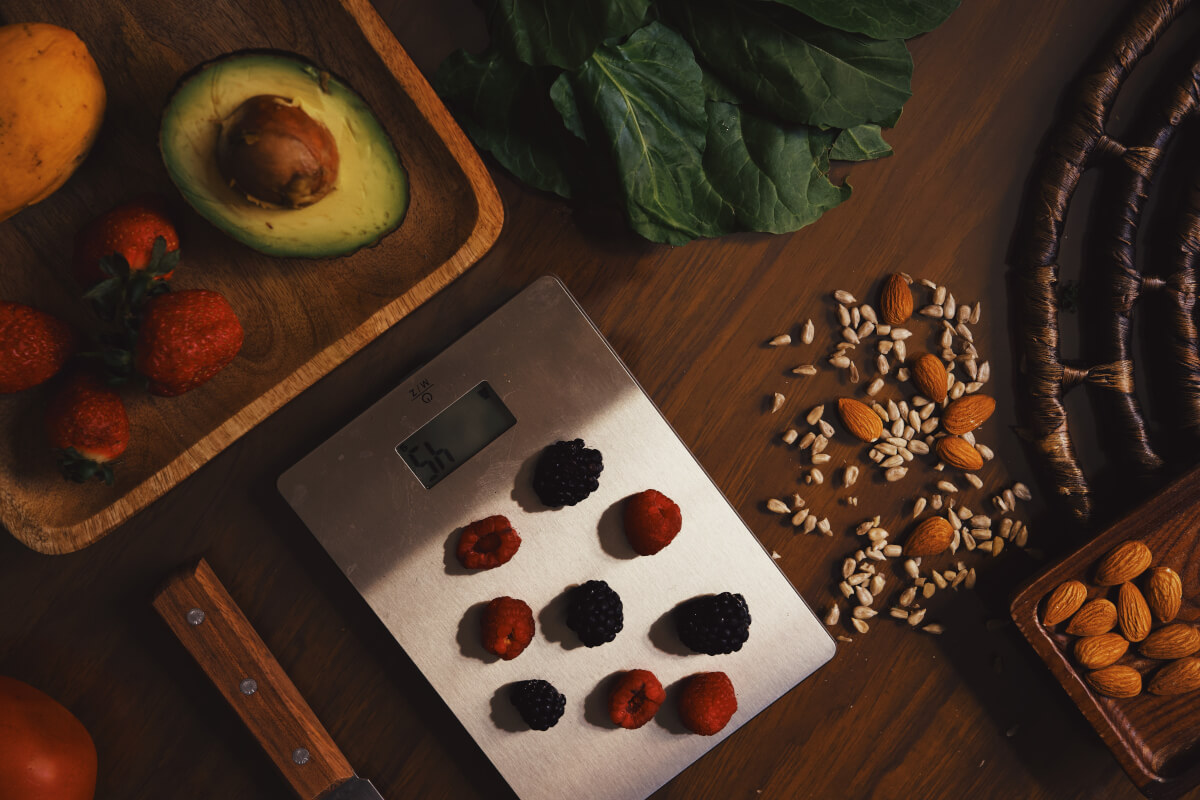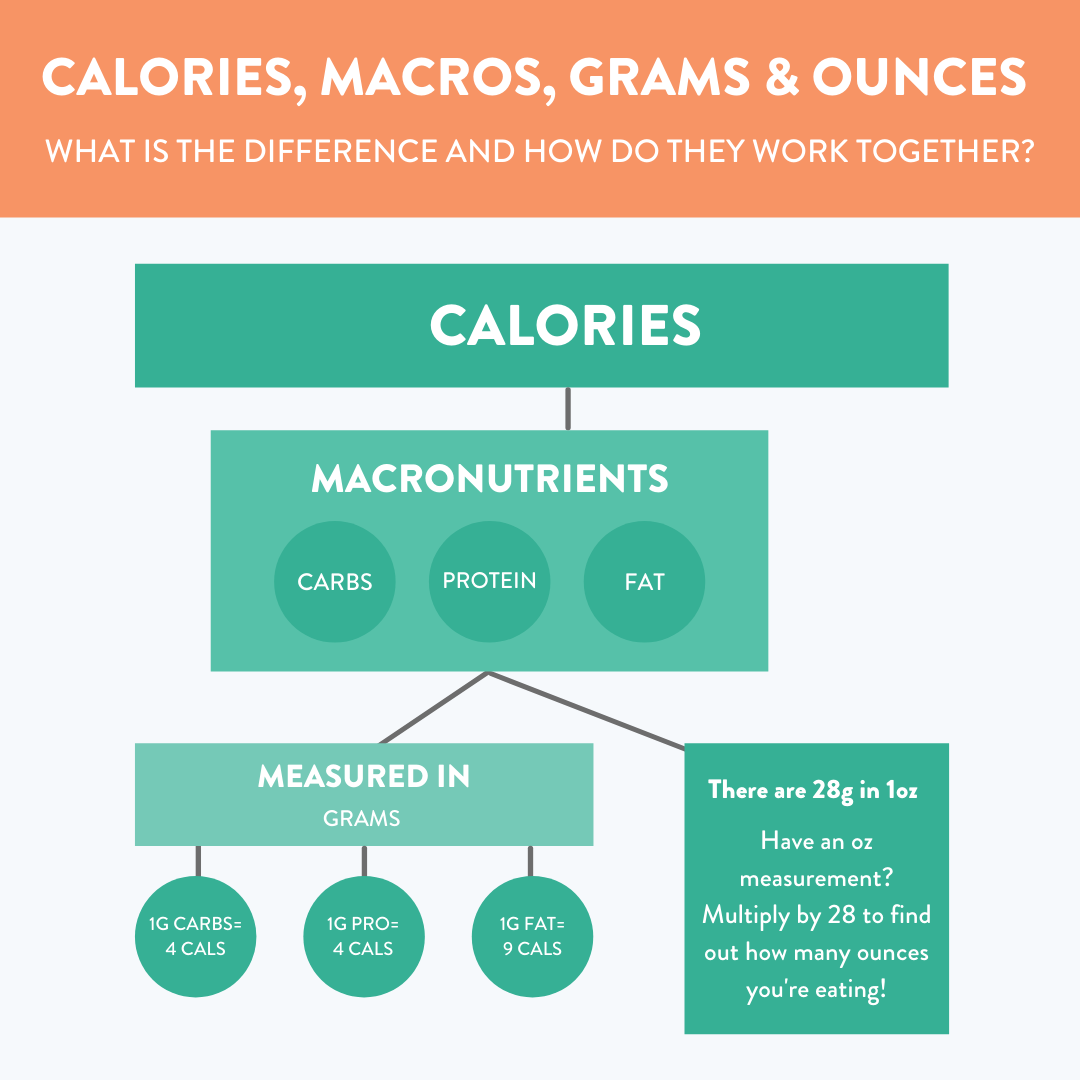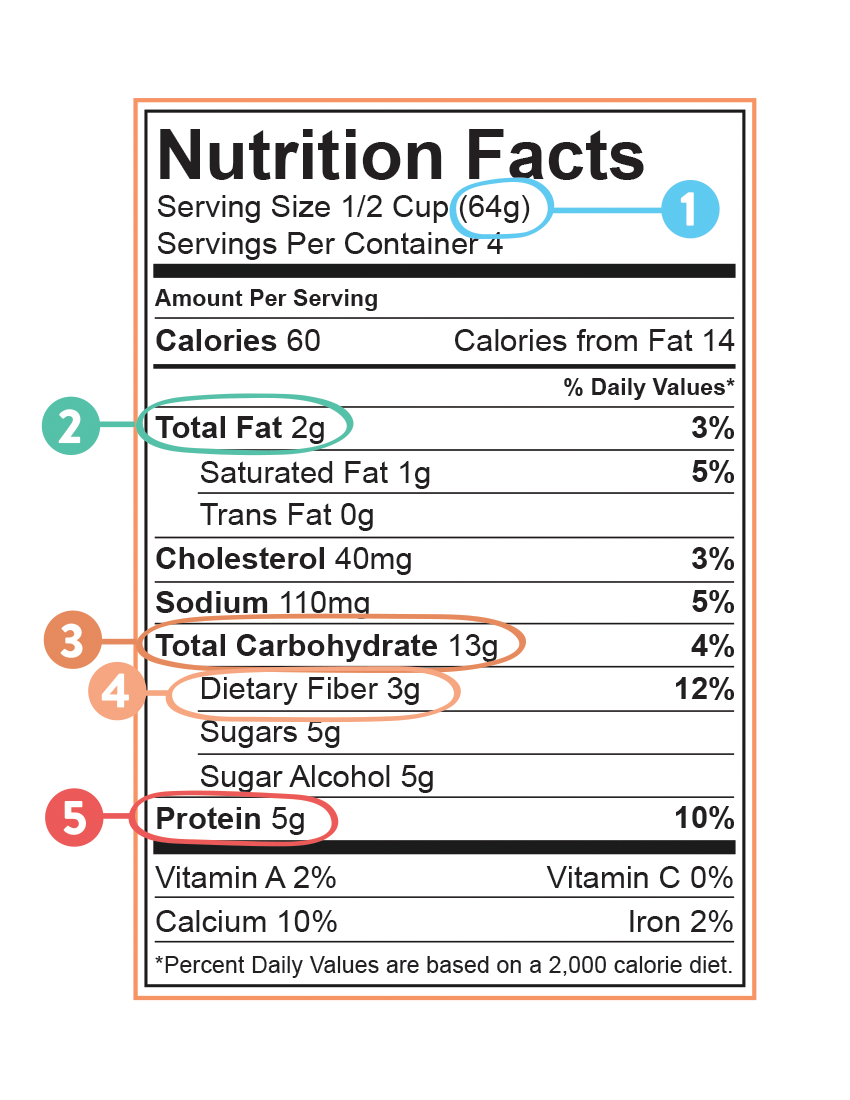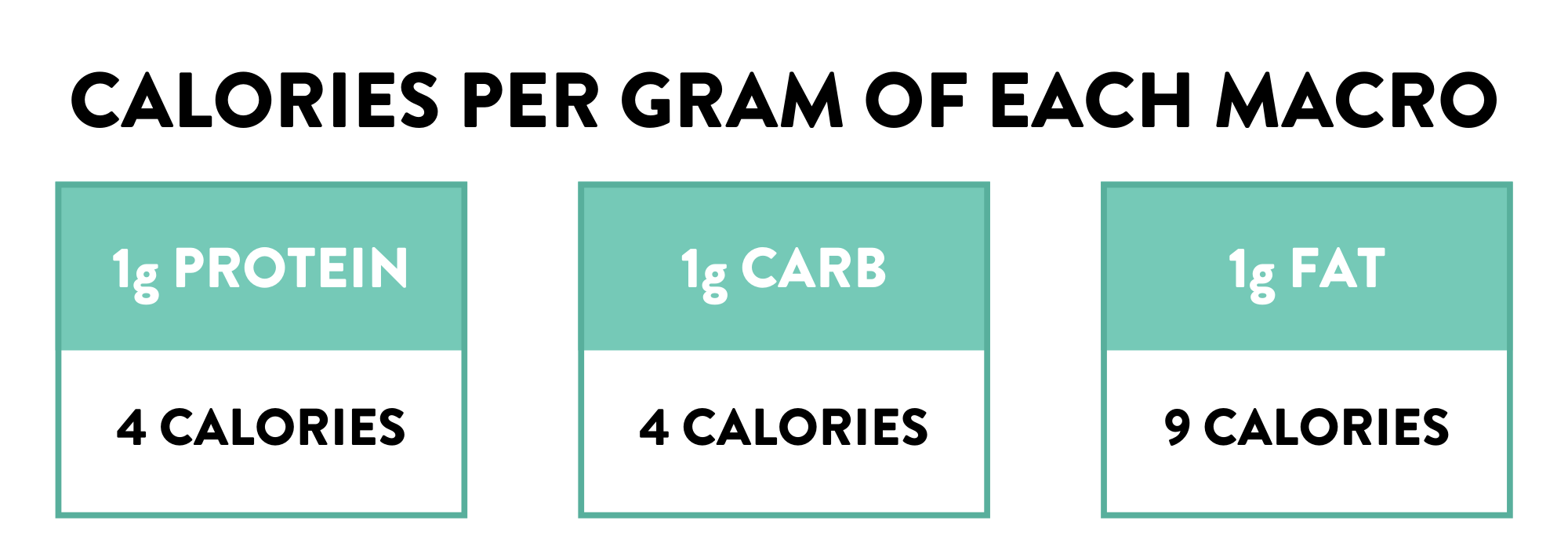
Calories, macros, grams, ounces…OH MY!
What is the difference between calories and macros and why is counting one often more effective than the other? How do grams and ounces play into this whole thing?
Have these questions ever crossed your mind? Do you feel like the difference between the two (wait, FOUR!) is a little blurry? If you answered yes, you are not alone.
Sometimes when you start something new, the lingo can be one of the biggest barriers to entry.
Take CrossFit for example: You not only need to learn how to perform the various movements but the abbreviations on the whiteboard (um… What is an AMSU and HSPU anyway?) can look and sound like a completely different language.
Advertisement
It can all be quite intimidating, especially when you feel like you are the only one who is in the dark.
So, let me start by telling you that you’re NOT the only one in the dark. We get this question all the time and today, we’re tackling the difference between calories, macros, grams, and ounces once and for all.
Learning the “Nutrition Language”
This same language-barrier, and resulting overwhelm, can happen with nutrition too.
Changes to diet and lifestyle can feel tough enough without adding the new terms. But once you learn the lingo you can more confidently reach your goals. So, what is the difference between calories and macros? And what are macros, anyway? Why are grams important and how are grams different from ounces?
To answer these questions, we need to start big and work small. Here is a road map you can come back to as you keep reading:
Advertisement

Let’s break down each level so we can see how they all work together to help you reach your unique goals.
What are Calories?
Before you can understand macros, we need to talk about calories.
Calories fuel your body. Technically speaking, a calorie is defined as the amount of heat needed to increase 1 gram of water by 1 degree Celsius. But, in terms of nutrition calories are a measure of the energy value of the foods and drinks we consume [1].
Simply put, calories equal energy and your body needs a certain amount of energy to sustain basic functions.
Advertisement
Counting Calories for Weight Loss or Performance Gains
Your total daily calorie consumption is specific to your sex, age, activity level, genetics, and more.
Generally, calorie balance is achieved when you take in the same amount of calories through food and drink as you exert through daily and physical activities including organized exercise, NEAT and other metabolic processes. Adjusting calorie balance determines if you are in a caloric deficit or surplus.
Counting calories can be a helpful place to start in your nutrition journey but it does not account for the type of nutrients you are consuming.
Calories are made of macronutrients (macros). Whether you are new to weighing and measuring your food or are a seasoned tracker, you have likely asked at one point or another, “what are macros?”.
How are Macronutrients Different Than Calories?
The three macronutrients (aka, “macros”) are protein, carbohydrates, and fats. The body requires macronutrients in relatively large amounts [2]. They make up the bulk of your diet and supply your energy as well as essential nutrients [2]. Knowing the difference between each macronutrient can help you understand how each impacts your fitness goals.
Advertisement
What are Carbohydrates?
Carbs are a single sugar unit that provide short-term energy. They are your body’s first choice for fuel. Carbohydrates are stored and used in two places: (1) as glycogen in your liver to maintain blood sugar, and (2) in your muscles to fuel exercise. The more active you are and the more muscle you have, the more carbs you need.
Need some quick ways to add carbs to your routine? Here ya go!
What is Protein
Protein is made of a combination of 22 amino acids (both essential and nonessential) and makes up your muscle, skin, hair, nails, eyes, and internal organs. Your body can make nonessential amino acids but you need to get essential amino acids from the foods you eat.
Your body relies on protein for fuel only in an emergency (when carbs are low). Protein consumption is crucial because your body cannot produce some of the essential amino acids on its own, it must get them from food sources. Protein is also important because it is responsible for muscle growth, healing from illness, and cell recovery. Athletes especially must consider the amount and quality of protein consumption to meet nutrient needs [3].
Here are some ways to add protein to your nutrition plan!
Advertisement
What are Fats
Fats facilitate the transport and absorption of vitamins such as A, D, E, and K. Omega-3 fatty acids support joint health, digestion, brain function, and cardiovascular health [4]. Fats also support healthy hormone production.
Fats digest slowly so they keep you fuller, longer and are a great long-term energy source for your body. Here are some ways to add healthy fats to your diet.
For a more comprehensive explanation of macronutrients, which foods to find them in, and their role in optimizing performance, check out the WAG Nutrition Guide.
Balancing your Macros
To ensure your body gets everything it needs for proper fuel and function, you need to consume a balance of each macronutrient. Each macronutrient contains micronutrients (vitamins and minerals). There are six essential micronutrients including vitamin D, iron, zinc, vitamin A, folate, and iodine, all found in the foods we eat [6]. When you eat too much of one macronutrient and not enough of another, you can miss out on important micronutrients.
It’s important to keep in mind that “balance” doesn’t mean the exact same amount of each. It means a combination of the three macronutrients in a ratio unique to you, your body, and your unique goals.
Advertisement
Macros and your goals
What are the best macros for weight loss? What are the best macros for muscle gain? No matter what your goal is, there is a ratio of macros that will support it, and counting macros versus calories is paramount to achieving fitness-related goals.
Exact numbers differ from person-to-person which is why working with a nutrition coach who gets to know you, your goals and your body is a game-changer!
Here are some general things to keep in mind that may help you narrow down what your body needs:
- Are you an endurance athlete? You may need a more even blend of carbs and fat so you have immediate and sustained energy in the tank.
- Are you a CrossFitter about to hit a quick WOD? You may need a few more carbs since they provide a quicker energy source than fats. You will want to avoid fats right before and a few hours before your workout since they slow the digestion of food and you need those carbs to turn into fuel!
- Weightlifting? You may need more protein to account for increased protein breakdown during and immediately after exercise. Protein breakdown and building is higher after resistance training. In order to build muscle, the body needs to store more protein than it is using as fuel - this is called being in “positive nitrogen balance”.
- Want to lose weight? You may need a different caloric deficit and balance of macronutrients based on your daily activity level and if you have a time constraint for your weight loss goal (wedding, beach vacation, etc.), as compared to someone else who wants to lose weight who is your same height and weight. Research shows that distribution of macronutrients impacts weight loss and that intake recommendations should be based on individual circumstances [3], such as gender and DNA for example.. Accounting for the balance of protein and carbohydrates in daily caloric intake improves overall weight management [3].
Each macronutrient is imperative to your diet and to your body’s performance. Progress comes from consuming the correct amount of each macronutrient for your goals, characteristics, and circumstances. Therefore, measuring and weighing food is important. This is how you determine the exact amount of any given macro you eat.
While macros and calories are what we intake, grams and ounces are the units used to measure that intake.
Advertisement
What Are Grams and Ounces?
Grams and ounces are units of measurement you’ll use to weigh your food. There are 28 grams in one ounce.
Grams and ounces measure the weight of the foods you put on your food scale. Volume measures how much space a food takes up. Volume is measured with cups and tablespoons.
If you’ve worked with a nutrition coach before, you have likely heard them say something like “higher volume foods keep you feeling fuller, longer.” This is because high-volume foods take up more volume (aka space) in your stomach!
The weight of foods (grams and ounces) is a more accurate representation of intake than using cups and spoons. If you take a peek at the back of a nutrition label in your kitchen, you’ll see something like this:

Advertisement
Here’s a breakdown of what you see:
- Serving size in grams. We recommend using grams vs. cups/spoons if you’re trying to be as accurate as possible.
- Amount of fat in this food.
- Amount of carbs in this food.
- Amount of fiber in this food.
- Amount of protein in this food.
It’s important to note that a label will give you the weight in grams or ounces but rarely both. With a little multiplication (and remembering that there are 28g in 1oz), you can figure out how many grams your food weighs even if you’re only given ounces on your nutrition label.
For Example:
Total grams in 4oz = 4oz x 28g/oz = 112g
Grams and your goals
You now know that the calories you consume are made of macronutrients and that macros are measured in grams (or ounces). But how exactly does this work?
Advertisement
Each gram of a given macronutrient is equivalent to a specific number of calories.

Here’s an example using a banana:
- Total weight in grams = 108g
- Grams from carbs = 24
- 24g X 4 = 96 cals
- Grams from protein = 1
- 1g X 4 = 4 cals
- Grams from fat = 0
- 0g X 9 = 0 cals
- Total calories = 96 + 4 + 0 = 100
It is important to note that not every banana is the same size and therefore weight. This is why weighing food and using measurements such as grams is crucial to your success. Let’s say you eat a banana every day and always use the macronutrient breakdown above for tracking purposes. Chances are there are days when your banana actually weighs more than 108g and therefore contributes to more of your carb intake.
If you track that your banana accounts for 24 grams of your carb intake for the day but it actually makes up 29 grams, that is a 5 gram (20 calorie) difference. If you ate a larger banana (at 29g) every day for five days, that is 100 more calories that you are consuming in a week that are not accounted for.
Advertisement
And hey, this happens now and then! A nutrition coach can help you catch these things so you’re not left wondering, “Why am I working so hard but seeing limited results?”. When you (and your coach) catch seemingly small tracking and weighing misses like this, it is a great chance to learn.
Accuracy paves the way for consistency and weighing and tracking food is the most effective way to achieve that accuracy. One of the easiest ways to keep track of your food and food measurements is by using a food tracking app like MacrosFirst or MyFitnessPal. Check out the Complete Guide to MyFitnessPal Tutorials to jumpstart your expert-level tracking.
That being said, flexible dieting is all about finding the balance between flexibility, sustainability, consistency, and accuracy that works best for YOUR unique body, goals, and lifestyle. Accuracy can teach you a lot about what your body needs and from there, you can experiment with letting go of precision and build trust with your body.
Whether you need to be as precise as possible to reach your current goal or you’re practicing your flexibility, learning the lingo is an important step in your weight loss and fitness journey.
It can be difficult to piece the information together, let alone put it into practice. We get the challenge, and this is where one-on-one nutrition coaching with WAG can come in handy. A WAG coach can work with you to determine your personalized macro breakdown based on your specific goals!
Advertisement
References:
- Centers for Disease Control and Prevention (n.d.). Session 7: Tip the calorie balance. https://www.cdc.gov/diabetes/prevention/pdf/handout_session7.pdf
- Youdim, A. (2019, May). Overview of nutrition. Merck manual professional version. https://www.merckmanuals.com/professional/nutritional-disorders/nutrition-general-considerations/overview-of-nutrition?qt=&sc=&alt=
- Martinez, J., Navas-Carretero, S., Saris, W., & Astrup, A. (2014). Personalized weight loss strategies-the role of macronutrient distribution. Nature Reviews Endocrinology, 10(12), 749–760. https://doi.org/10.1038/nrendo.2014.175
- National Center for Complementary and Integrative Health (2021, July 27). 7 things to know about omega-3 fatty acids. https://www.nccih.nih.gov/health/tips/things-to-know-about-omega-fatty-acids
- Dietary Supplements. (2021, March 29). Dietary supplements for exercise and athletic performance. https://ods.od.nih.gov/factsheets/ExerciseAndAthletic%20Performance-HealthProfessional/#en155
- Centers for Disease Control and Prevention (2021, June 28). Micronutrient facts. https://www.cdc.gov/nutrition/micronutrient-malnutrition/micronutrients/index.html
Schedule a Free Intro Call
Working Against Gravity has led the macro tracking and health space for over a decade. Our team doesn’t just understand the science of nutrition—we’ve spent years mastering the art of tailoring it to fit your life. That means no cookie-cutter plans, just real strategies that have worked for over 30,000 people.
Schedule a free call with our team to learn how working with a 1-on-1 WAG coach will help you reach your goals.



